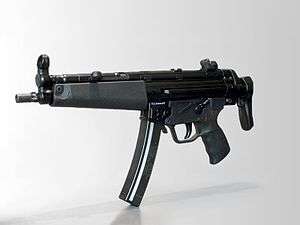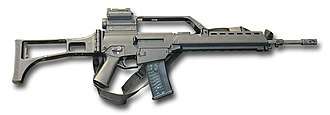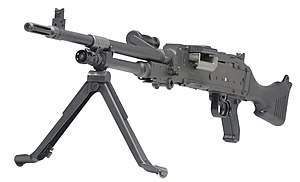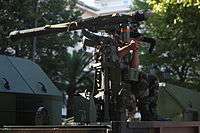Presidential Security Group
The Presidential Security Group, or PSG for short[1][Note 1] is a Philippine close protection agency. It is the primary agency concerned with providing close-in security and escort to the President and the Vice President of the Philippines, their immediate families, former Presidents and Vice Presidents of the Philippines as well as visiting heads of state.
| Presidential Security Group | |
|---|---|
.svg.png) Coat of Arms of the PSG | |
| Active | March 6, 1897 - Present |
| Country | |
| Branch | Army, Navy, Air Force, Marines, Coast Guard, and Police. |
| Role |
|
| Size | 1 Brigade/Regiment, 3 Battalions. Total is 4000+ soldiers, police, coast guard and civilian personnel |
| Part of | Office of the President of the Philippines Department of National Defense |
| Garrison/HQ | Malacañang Park, Malacañang Palace, Manila |
| Nickname(s) | PSG, The President's Guards, Presidential Guards, Filipino Secret Service, Men in Barong, PSG Troopers |
| Motto(s) | Integrity, Service, Excellence |
| Mascot(s) | Eagle |
| Anniversaries | March 6 |
| Decorations | Presidential Streamer Award, Philippine Republic Presidential Unit Citation Badge |
| Website | http://psgtroopers.com/2017/ |
| Commanders | |
| Current commander | Col. Jesus P. Durante III, GSC, PA |
| Notable commanders |
|
| Insignia | |
| Unit Patch | PSG Badge |
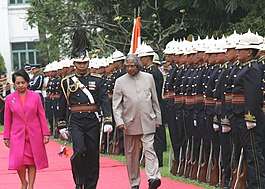
The PSG is stationed at Malacañang Palace, the official residence of the President. Members of the PSG also accompany the President on both domestic and overseas trips.
History
While the present-day force was established in 1987, the protection of the President and the Presidential Family has been always the duty of the Armed Forces of the Philippines since 1897. A guard unit was raised at the time to protect the first official President, Emilio Aguinaldo, from attempts on his life, while another was formed for the defense of Andrés Bonifacio, the Supremo of the Katipunan revolutionary movement, as a result of the decisions of the Naic Conference. In 1898, a presidential cavalry squadron was raised for the protection of President Aguinaldo and his family, reinforced with a guards infantry company. Like today's PSG, they wore rayadillo uniforms, but with straw hats. Major Geronimo Gatmaitan was the unit commander.
In 1936, the 1st Cavalry Regiment of the 1st Infantry Division, Philippine Army, raised the same year, was tasked with defending President Manuel Quezon, his family, and the palace complex. They were joined by a guards company in 1938 to reinforce the President's security.
During the Second World War, units of the occupying Imperial Japanese Army initially took over guard duties at the palace, only to be replaced by an all-Filipino guard battalion at the insistence of President José P. Laurel. At war's end, it was in turn replaced by the AFP Presidential Guards Battalion under the orders of President Sergio Osmeña. The PSG of today traces its origins to 1950 when a presidential security unit was founded under the orders of President Elpidio Quirino as the secret service and protective unit of the state presidency, the First Family, and Malacañang Palace, under the control of the Philippine Constabulary (then the Secret Service of Malacañang Palace and later the Presidential Security Force and Presidential Security Agency and Presidential Security Command).
When President Corazon Aquion was sworn in as president, she gave the order to disband the PSC and replace with the PSG.[2] The PSG, then as in the present, has always included both civilian agents and seconded servicemen from the Armed Forces.
The PSG launched the PSG Troopers website on February 10, 2017 as part of an effort to improve public relations.[3] Information concerning President Duterte's security arrangement are considered as classified.[3]
Four PSG officers were wounded in an encounter with New People's Army guerillas in Arakan, North Cotabato after they were spotted running a fake vehicle checkpoint.[4]
On September 26, 2017, a PSG officer was found dead inside the Malacañang complex with a gunshot wound to the chest.[5]
Role
The role of the PSG is tasked with:[6]
- Providing security to:
- The President and his/her immediate family.
- The Vice President and his/her immediate family.
- The President-elect and his/her immediate family.
- The Vice President-elect and his/her immediate family.
- Former Presidents and their immediate families.
- Former Vice President and their immediate families.
- Visiting heads of states or diplomats and Cabinet Members and their families travelling with them.
- Provide escort security for them at all times.
- Securing the President and Vice President's residences, offices and places of engagements.
- Surveillance and Monitoring activities.
- Perform state protocol duties including honor guard duties
The Presidential Security Group also have other functions, such as providing support to other government agencies. They assist the AFP and PNP in its anti-organized-crime undertakings, usually authorized by the Office of the President. They also conduct community service efforts in local communities, and maintain and secure all facilities and transportation assets used by the Offices of the President and Vice President in doing its regular and non-regular functions.[7]
Organization
The following are organized under the PSG as of 2010:[8][9]

Key Personnel
- Commander, either a Colonel or Brigadier General
- Chief of Staff
- Special Reaction Unit Commander
- Commanding Officers
- Headquarters and Headquarter Service Battalion
- Security Battalion
- Presidential Escorts Battalion
- Presidential Guards Battalion
Units
- Headquarters & Headquarters Service Battalion
- Presidential Escorts - the actual personnel accompanying the President and Vice President
- Guard Battalion
- Security Battalion
- Special Reaction Unit / K9 Unit
- PSG Station Hospital
- PSG Dental Dispensary
- Presidential Intelligence Company
- PSG Training School
- PSG Band
Recruitment
Agents are usually personnel from the Armed Forces of the Philippines and the Philippine National Police. However, there are a few civilian personnel acting as support units. They receive rigorous training which befits their position enabling them to fulfill their duties of protecting the President, Vice President and all others which they may be tasked of protecting, and be prepared to sacrifice their lives if ever the need arises.
Equipment
PSG members are known to carry assorted firearms, some known firearms include:
The PSG utilizes Motorola trunked two-way radios with encryption capability.[11]
Vehicles

.jpg) Toyota FJ Cruiser
Toyota FJ Cruiser- An unmarked Toyota Fortuner with a lightbar siren mounted on top of the SUV
 Mitsubishi Montero Sport
Mitsubishi Montero Sport- Philippine Army M113
References
- http://psg.mil.ph/ PSG Official Page
- "Archived copy". Archived from the original on 2018-04-18. Retrieved 2018-04-18.CS1 maint: archived copy as title (link)
- Ranada, Pia. "Presidential Security Group launches website". Rappler.
- Admin, PSG Troopers Website (July 19, 2017). "PSG encounters NPA at Arakan North Cotabato".
- Corrales, Nestor. "PSG officer found dead in Malacañang complex". newsinfo.inquirer.net.
- ""PSG" (Documentary by Sandra Aguinaldo)". GMA News. 2011-01-07. Retrieved 2011-07-16.
- "FEATURE | Former PH presidents given 8 security personnel".
- "NGA" (PDF). www.coa.gov.ph. 2010. Retrieved 2019-11-04.
- Admin, PSG Troopers Website (July 5, 2018). "121 Years of Selfless Service and Dedication to Duty".
- "Develop Philippine arms industry, group urges". philstar.com.
- "Philippine Daily Inquirer - Google News Archive Search". news.google.com. Retrieved 2016-07-01.
External links
| Wikimedia Commons has media related to Presidential Security Group. |
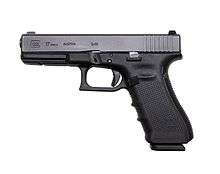
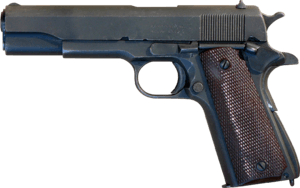
_modified.jpg)
